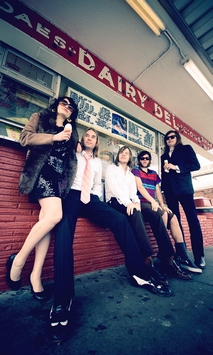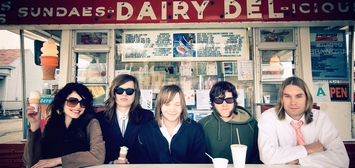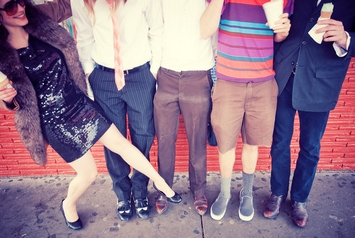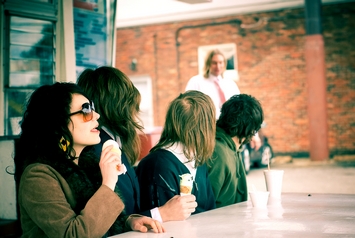social bookmarking tools:
 |
|
| Available RSS Feeds |
|---|
 - Top Picks - Top Picks |
 - Today's Music - Today's Music |
 - Editor's Blog - Editor's Blog
|
 - Articles - Articles
|
Add Louisville Music News' RSS Feed to Your Yahoo!
|

THE LADYBIRDS:
THE RAW, THE RUGGED, THE LOVELY, ALL IN WALL-OF-SOUND GLORIOUS MONO
By Tim Roberts • Photos by Laura Roberts
It's gone now: Gold Star Studios in Los Angeles. Closed in 1984 after more than three decades of business. The next year, a fire damaged the structure. A year after that, it was demolished, flensed from the landscape and consigned only to memory and a few pages of music history. In the 1960s producer Phil Spector used the studio's precisely constructed echo chambers to create a style of music identified not by where the studio was or who ran the place, but only by its sound: massive, endless ambience, as if the entire outdoors had been squeezed into 20-foot-by-20-foot-by-20-foot cube and every note was captured in it. The wall of sound, it was called. Music tagged by that production style is unmistakable, whether it was recorded at Gold Star or not: "Be My Baby," "You've Lost That Lovin' Feeling," "He's a Rebel," "The Sun Ain't Gonna Shine Anymore," the William Shatner version of "Lucy in the Sky With Diamonds."
It's still there: Sun Studio in Memphis. Home base for the genesis of rock at the intersection of Blues and Country, where one emptied into the other like two large rivers to form a third, larger and deeper and from which four young men named Cash, Lewis, Perkins and Presley and later another named Orbison, would embark, scouting out the territory, finding safe harbors and snarly entanglements. The Sun River emptied into a larger sea and eventually the sounds from these men traversed it and came ashore at a seaport in western England, then emptied into a river called Mersey.
The two sounds created in each space, one in the American south, an area respectful of traditions, the other in the American west, a place of innovation, have melded together and folded upon themselves for more than four decades.
For the Louisville band The Ladybirds, the tradition and innovation from both those influences was perfect for the sound they wanted to make.
"We wanted this to sound like a cross between Gold Star Studios in Los Angeles and Sam Philips' Sun Studios," guitarist Max Balliet said of Whiskey & Wine, the band's 2007 debut.
"We did that pretty well," said bassist Jaxon Swain. "The instruments are all single-tracked. It's all live-sounding in a Sun Studios type of way. But the vocals are all double-tracked to give it that wall of sound."
Balliet agreed. "There's some air in there."
There's a saying that milk takes the flavor of what ever it is closest to in the refrigerator. Of course, this was back when milk was either in thin wax containers or in glass bottles with foil caps that never stayed on. So it seems that the members of The Ladybirds were shoved in next to 1950s rockabilly, 1960s wall-of-sound pop and 1970s proto-punk and glam and absorbed nearly every hook and note.
"We love '50s rockabilly," gushed vocalist Sarah Teeple. "I know we all love '70s early punk, like the New York Dolls and The Stooges."

My wife and I were in a booth at the Monkey Wrench with the three core and founding members of The Ladybirds: Teeple, Balliet and Swain. Its corner location in the Original Highlands neighborhood began as a cleaners and laundry, then it functioned as a pita restaurant that later moved up the street. As the Monkey Wrench, it still has the concrete floors and pillars from its days of detergent and dryer lint, but the décor is now awash in indigo. The SEC tournament was on the TV over the bar. The restaurant was empty except for us, a couple seated at a booth against the window and two guys in dress shirts and ties drinking beer and commenting loudly on the game.
"There's a little bit of punk still in us, too," said Balliet. "We all kind of grew up listening to a lot of it."
Formed when Teeple (from Louisville) and Swain (from Syracuse, Indiana) met in Bloomington as students at Indiana University, along with Balliet, who was in a Louisville band that visited the campus. The Ladybirds, like many other acts, resulted from shared interests in snippets of music styles that span the decades of rock instead of the canon of an entire genre.
Teeple and Swain moved to Louisville in 2004, called Swain and the three began developing The Ladybirds, borrowing their sound from the genres they love, favorite albums and specific songs. Putting the band together was like building a three-course meal at the Blue Boar Cafeteria. The only difference is they didn't have to ask for what they wanted from surly old ladies in white uniforms and hairnets. It was like making the mix tape of your dreams with yourself as the star.
"It's also worth noting," said Swain, "I say this all the time and I don't know how much this comes out in our music, but," he paused, carefully selecting his words as he was picking through diamonds scattered on a square of velvet at some jeweler's in Antwerp, "there's sort of a girl-group type of thing."
"Our first [band] concept," Teeple said, "was to have some backup singers.
"Three singers," Balliet added, "just like a girl group."
"But because of circumstances and other things, that sort of took a back seat. But we're still always coming from that angle, but it just doesn't shine through as much."

"We changed our mind about it because we got sick of looking for them," Swain added. "We decided just to play a show to see how it goes just with Sarah. And it worked well."
On stage, the band's presence fits the melting-pot concept of the music from which they borrow. Teeple's thick, dark hair is normally bunched-up on the back of her head. She wears a short, empire-waist dress and cowgirl boots. The rest of the guys in the band wear sports jackets, dress shirts with wide-tabbed collars and ties with knots as thick as a fist, their hair long and platted down. It's as if the granddaughter of rockabilly queen Wanda Jackson had time-tripped back to sing with a prom band for the Class of 1973.
When it came time for The Ladybirds to commit their music to something permanent, their stage sound transferred easily to the recording studio. In early 2006, they used Kevin Ratterman's Funeral Home studios in western Louisville to record the 10-song Whiskey & Wine. And like a lot of the acts that inspired the band did in the early days of rock, they recorded all the tracks in one day and mixed them the next.
"We sort of had limited resources," Teeple said. "We did it basically in two days. It was a haul-ass kind of thing. We recorded it in 2006, then we played some shows and did some fund-raising to release it and get all the cover art and stuff. We had a lot of help from a lot of artist friends around town to help make our Ladybirds logo and do our photography."
Now that many bands and individual performers can make a complete recording with a microphone, an instrument and a laptop computer running audio software and, in some cases, create their own cover artwork, a full studio production (even if it was crammed into two days) like Whiskey & Wine is not as common as it once was. For years a DIY record was considered a novelty, something as quaint as a knitted doily. Now it is almost expected. But The Ladybirds had a gimmick for their production to separate it from a DIY project: it was recorded in mono, as the big black letters on the CDs back subtly inform you.
Why? "So many of our favorite albums are in mono," Swain said. "And I love mono [the type of audio production, that is - Author]. It's just right in your face. It's a very accurate representation of what we sound like."
"We wanted it close to being live without too much production mumbo-jumbo," Teeple added. "It's pretty straightforward. It's an homage, kind of a cool thing to do."
"All three of us love '50s rock-and-roll," Swain said. "And we love '60s and '70s stuff, too."
"Different genres," Teeple said, "a little from each decade. One crucial album that Max and Jaxon and I get together and listen to is MC5's Back in the USA."
"While we were making the album," Balliet said, "we listened to that all the time. That's why we did the cover of 'Teenage Lust' on it."

The two recordings, Whiskey & Wine and Back in the USA, both have a raw, under-produced quality, done intentionally, that scours the music down to where it is only essence, almost ghostly, to where only the sound matters and individual instrumentation has surrendered to something primal. The songs become as ethereal as memories. When you hear "Dreamboat" on Whiskey & Wine, you imagine it being lip-synched by three slim women in tight hourglass dresses on "American Bandstand." When you hear the blues-laden title track, you can imagine a lonely woman being rescued from a honky-tonk where the woodwork is moist with spilled beer and heartache. These are songs someone has lived through.
In between the time the album was finished and finally released, the band's drummer Sean Johnson had left (the main reason you see only the core trio of Teeple, Balliet and Swain on the cover). But they have since added a new one, Justin Shaw. They have also broadened their sound by adding Anthony Fossaluzza and his Hammond CV organ. Getting it around to gigs and to rehearsals is like moving a piece of furniture around, according to Balliet.
Hauling Fossaluzza's Hammond (sounds like a good name for a spin-off band) is a necessary task, but it's a smaller one compared to the challenge the members of The Ladybirds agree is their biggest.
"The big one right is now is our trying to do more things as a band and get on the road," Swain said.
"It's kind of the middle ground between wanting to do this full time but not being able to support yourself on that," said Teeple. "Trying to balance jobs and other peoples' work schedules and trying to get out on the road. A lot of it comes down to the dough."
To try to start earning that dough as full-time musicians, while weaning themselves away from Louisville-only gigs, the band is scheduled for a pair of out-of-town performances: one in April at Uncle Fester's in Bloomington, another in May in Chicago.
"We definitely want to try to get out of town some more," Teeple said. "We love Louisville, but we wouldn't mind skipping town for a little while."
And that's not because they think the city's music scene is dead, dying, or even square (daddy-o). Finding new cities to play in is only a natural instinct for musicians interested in building a larger, broader audience, which is important for a band like The Ladybirds with its various, eclectic influences.
"I think it's kinda hard for us," said Teeple, "because we have a lot of different influences, as most bands would say they do. It's hard to fit into any category because it feels like we're not indie enough for the indie rockers. . ."
"Or artsy enough," added Swain.
"Or we're not straight rockabilly. Or just straight dirty, dirty punk enough for the punker-than-thou crowd. We've definitely got our fans, but we're for anyone who just loves true, traditional rock-and-roll.
"We're a little more of a concept kind of band," Swain said. "But we're not arty enough. I think we are in our own small way. We don't really go for that. There's a little bit more to us that we can't play every night in town. We're not that kind of band, either."
What The Ladybirds are, then, is an amalgam of specific influences that has shaped popular music over the last half-century: tradition and experimentation, the sound born in one region melding with a sound that was manufactured in another, both tapping into the shared memories of music we've heard through our transistor radios late at night or while digging through gigabytes of data on the Internet.
In the meantime, The Ladybirds take their sound and do with it what they've always done best:
"We pride ourselves on musicianship," Baillet said. "What we do best is a live show."
Find your musical memories at www.ladybirdsrock.com or www.myspace.com/theladybirds.
